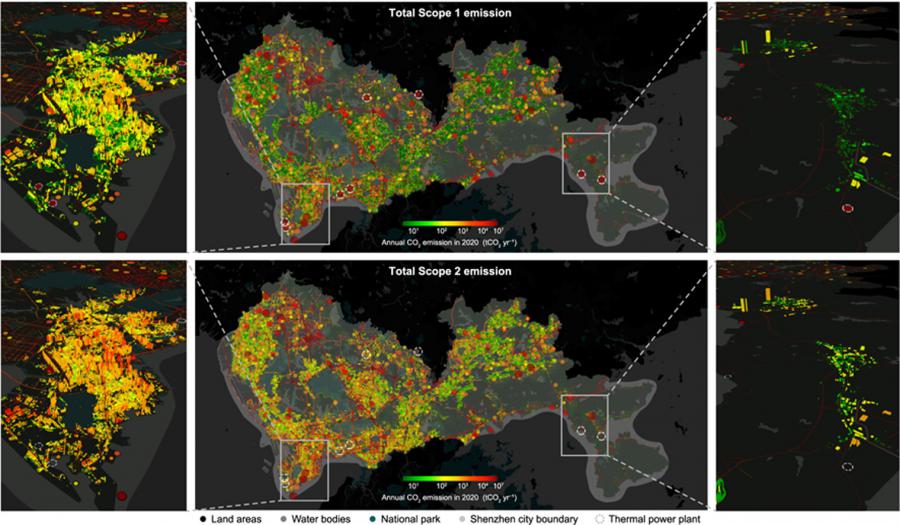
Rethinking urban carbon: from power plants to people
GA, UNITED STATES, July 28, 2025 /EINPresswire.com/ -- As cities become the frontline in climate action, understanding their internal carbon dynamics is crucial. A new study presents a high-resolution emissions mapping framework for megacities, revealing how carbon responsibility has shifted from centralized producers—like power plants and factories—to distributed end-users, such as homes and businesses. Using Shenzhen as a model, researchers integrated Scope 1 (direct) and Scope 2 (indirect) emissions across sectors and space, capturing emissions at the street, building, and 1 × 1 km2 district levels. This detailed approach not only uncovers the hidden carbon flows within urban systems but also highlights key areas for policy intervention, enabling cities to design fair and effective carbon mitigation strategies.
Urban areas are home to over half the world's population and emit more than 70% of fossil-fuel-derived carbon dioxide (CO2). Among these, megacities face mounting pressure to balance rapid development with climate goals. However, existing emissions tracking methods often rely on coarse annual citywide totals, obscuring the spatial and sectoral diversity of emissions. Most notably, traditional inventories focus on Scope 1 emissions—direct outputs from within city limits—while neglecting Scope 2 (indirect) emissions from imported electricity, which can be substantial. This limited view hinders effective policymaking. Based on these challenges, there is a pressing need to conduct fine-scale, integrated analyses of urban carbon flows to guide equitable and precise climate actions.
Researchers from the Tsinghua Shenzhen International Graduate School have published a study (DOI: 10.1016/j.ese.2025.100602) on July 12, 2025, in Environmental Science and Ecotechnology, unveiling a novel carbon accounting model for megacities. Focusing on Shenzhen, China, the study combines building simulations, traffic data, industrial data, and land use to map both Scope 1 (direct) and Scope 2 (indirect) emissions down to individual structures. The findings reveal a major shift in carbon responsibility from producers to consumers and offer a scalable framework to support low-carbon urban transformations worldwide.
The team developed a high-resolution framework that quantifies and spatially allocates CO₂ emissions by integrating fuel-specific industrial data, building-level electricity usage, and real-time traffic flows. In 2020, Shenzhen's total CO₂ emissions reached 52.0 Tg, with 44.8 Tg (86.3%) from Scope 1 and 7.2 Tg (13.7%) from Scope 2 sources. While power plants and road traffic dominated direct emissions, indirect emissions from electricity use in residential, commercial, and industrial buildings accounted for over 60% of total Scope 2 emissions. Notably, when emissions were reallocated to consumption points, emission hotspots expanded from 0.7% to 12.7% of city area, revealing broader responsibility beyond traditional industrial centers. The study also found that 84.8% of Shenzhen's districts are consumption-led, emphasizing the need for energy efficiency and green buildings. By uncovering disparities in emissions across districts and population densities, the study offers actionable insights for targeting reductions where they are most impactful. This bottom-up approach bridges the gap between macro targets and micro interventions, enabling cities to tailor mitigation strategies with unprecedented precision.
“Our research demonstrates that cities must move beyond total emissions and consider where, how, and by whom emissions are generated and used,” said Prof. Bo Zheng, co-author of the study. “By revealing the hidden carbon flows linked to electricity consumption, especially in high-density districts, our landscape-level framework empowers urban planners and policymakers to design interventions that are both effective and equitable. As more cities adopt similar tools, we can accelerate the path toward climate neutrality.”
This study sets the stage for smarter carbon tracking in megacities worldwide. The landscape-level framework can inform targeted policies, such as installing solar panels on high-consuming buildings, promoting energy-efficient designs, and transitioning to cleaner power sources in production-led zones. Moreover, it supports climate justice by clarifying who bears carbon responsibility in complex urban ecosystems. With broader adoption, especially in cities heavily reliant on imported electricity, this model can help governments and citizens take coordinated, data-informed steps to meet emission reduction goals—transforming not just how we measure urban carbon, but how we act on it.
DOI
10.1016/j.ese.2025.100602
Original Source URL
https://doi.org/10.1016/j.ese.2025.100602
Funding information
This work was supported by the Shenzhen Science, Technology, and Innovation Commission (Grant No. WDZC20220810110301001).
Lucy Wang
BioDesign Research
email us here
Distribution channels: Environment, Science
Legal Disclaimer:
EIN Presswire provides this news content "as is" without warranty of any kind. We do not accept any responsibility or liability for the accuracy, content, images, videos, licenses, completeness, legality, or reliability of the information contained in this article. If you have any complaints or copyright issues related to this article, kindly contact the author above.
Submit your press release
